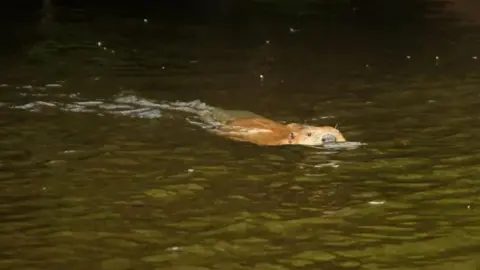## A Significant Wildlife Sighting: The Return of the Wild Beaver
A recent video featuring a wild beaver in Wales has captivated audiences and experts alike. This remarkable sighting is noteworthy because it marks a significant turn in the environmental landscape of Britain, where beavers were absent for nearly 400 years. Historically hunted to extinction, the resurgence of beavers in the ecosystem signals a positive trend in conservation efforts.
The footage was captured along the banks of the River Dyfi, near Machynlleth. Naturalist and BBC presenter Iolo Williams described the encounter as one of the “very, very best” moments he’s ever experienced. He emphasized the importance of this sighting, stating, “The last people to see wild beaver in Wales would have been the Welsh princes, who would have hunted them. So they’ve been absent for hundreds of years. So it’s hugely significant.” Indeed, the return of these semi-aquatic mammals not only revives a piece of British history but also reinstates their crucial role in the ecosystem.
### The Beaver’s Comeback
Beavers disappeared from British waterways about four centuries ago due to excessive hunting and habitat destruction. In the last two decades, however, conservation initiatives have allowed for their controlled reintroduction across various parts of the UK. Currently, there are four managed enclosures for beavers in Wales, accompanied by an unknown number thriving in the wild. The increasing presence of these animals in their natural habitat serves as a testament to the ongoing efforts toward wildlife conservation.
During the filming of the BBC series “Iolo’s River Valleys,” Williams meticulously set out to observe and document the wild beaver’s behavior. Upon arriving at a specified location on the River Dyfi, he was thrilled to discover the beaver calmly going about its activities: swimming and feeding. This particular sighting comes as a relief, as previous attempts to catch a glimpse had been thwarted by bad weather.
### Implications for Wildlife and Conservation
Environmentalists, including Alicia Leow-Dyke from Wildlife Trust Wales, believe that this sighting suggests that a beaver family might be establishing itself along the river. Evidence indicates that breeding has been occurring, making the re-establishment of beaver populations in Wales promising for biodiversity. These creatures are renowned for their ecological contributions; by building dams and lodges, they create habitats that benefit numerous other species.
The beaver’s return could lead to improved wetland habitats and even assist in flood control, primarily in headwater streams. Dr. Robert Needham from the Beaver Trust highlighted that beavers function as “ecosystem engineers,” enhancing habitat diversity and ecological resilience. “They can help restore our wetland habitats, which are massively lost throughout Europe, let alone Great Britain,” he remarked.
### Controversies and Challenges Ahead
While many celebrate the beaver’s return, concerns remain. Critics argue that these animals can generate problems for farmers, including flooding fields and damaging crops. Aled Jones, the president of NFU Cymru, articulated the need for a balanced approach to wildlife management, stating, “We can’t allow an indiscriminate approach where farming businesses are severely impacted.” Farmers’ livelihoods are closely tied to land sustainability, and the reintroduction of beavers raises valid questions about land management and agriculture in areas where beavers reside.
Despite these concerns, the Welsh government will consider protective legislation for beavers, particularly as wildlife charities advocate for their release into rivers across Wales. This evolving situation demonstrates the complex relationship between wildlife conservation and agricultural practices, prompting discussions about coexistence and sustainable management of natural resources.
### Conclusion
The sighting of a wild beaver in Wales presents both a hopeful resurgence for biodiversity and a set of challenges for land management and agricultural practices. The awe-inspiring nature of this encounter is a reminder of the delicate balance in ecosystems and the importance of conservation efforts. As Iolo Williams succinctly put it, witnessing a wild beaver was not only an incredible wildlife moment but an event with significant ecological implications for future generations. As we continue to explore the impact of wildlife on our environment, this moment stands as a wonderful representation of nature’s resilience and the ongoing endeavor to restore and protect it.
With footage of the beaver so readily available and reminders of the past echoed in these moments, the relationship between humans and wildlife has never seemed more pressing. As the date approaches for the airing of “Iolo’s River Valleys” on BBC Two and BBC One Wales, the anticipation builds not just for the documentary, but for a greater awareness of our surrounding ecosystems and their inhabitants.



